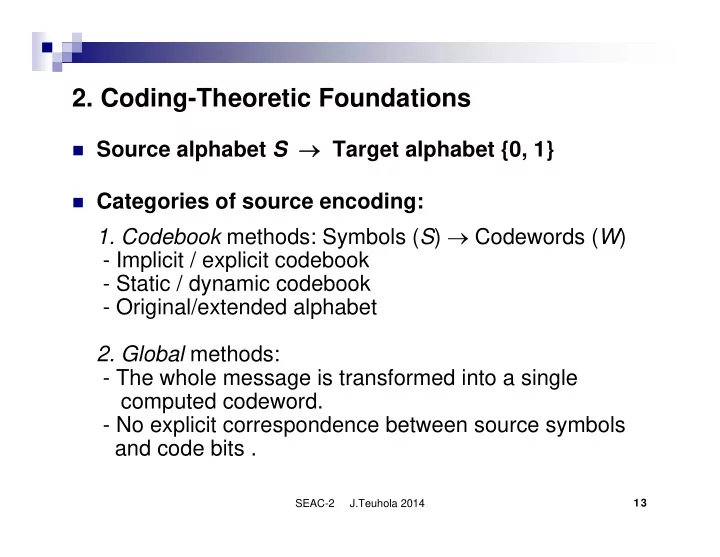

2. Coding-Theoretic Foundations � Source alphabet S → Target alphabet {0, 1} � Categories of source encoding: 1. Codebook methods: Symbols ( S ) → Codewords ( W ) - Implicit / explicit codebook - Static / dynamic codebook - Original/extended alphabet 2. Global methods: - The whole message is transformed into a single computed codeword. - No explicit correspondence between source symbols and code bits . SEAC-2 J.Teuhola 2014 13
Illustration of coding approaches Encode single Encode blocks Encode the message symbols of symbols as a single block Source message Source message Source message Codewords Codewords Codeword SEAC-2 J.Teuhola 2014 14
Requirements of a codebook � Uniqueness: s i ≠ s j ⇒ C ( s i ) ≠ C ( s j ) Sufficient for fixed-length codes � Length indication: required for variable-length codes. Alternatives: � Length prefixes the actual code (but length must also be coded …) � ‘Comma’ = special bit combination indicating the end � Carefully selected ‘self-punctuative’ codewords � Example of an ill-designed codebook: ‘a’ = 0 Code string 00110 ‘b’ = 01 results from either ‘c’ = 11 ‘dca’ or ‘aaca’ ‘d’ = 00 SEAC-2 J.Teuhola 2014 15
Graphical representation of a codebook Decoding tree (decision tree) � Left son = bit 0, right son = bit 1 � Prefix-free code: Binary tree (usually complete); each symbol is represented by a path from the root to a leaf, e.g.: ’a’ 0 Code table: 0 ’b’ ’a’ = 0 1 ’b’ = 10 0 ’c’ 1 ’c’ = 110 ’d’ = 111 1 ’d’ SEAC-2 J.Teuhola 2014 16
Properties of codes � Some general codebook categories: � Uniquely decodable (decipherable) code � Prefix-free code (= prefix code) � Instantaneous code � Kraft inequality: An instantaneous codebook W exists if and only if the lengths { l 1 , ..., l q } of codewords satisfy q 1 ∑ ≤ 1 l 2 i = i 1 � MacMillan inequality: Same as Kraft inequality for any uniquely decodable code. � Important: Instantaneous codes are sufficient. SEAC-2 J.Teuhola 2014 17
Infinite, countable alphabet � E.g. Natural numbers 1, 2, 3, … without limit � No explicit codebook � Codes must be determined algorithmically � Requirements: � Effectiveness : There is an effective procedure to decide, whether a given codeword belongs to the codebook or not. � Completeness : Adding a new code would make the codebook not uniquely decipherable. SEAC-2 J.Teuhola 2014 18
Application of coding arbitrary numbers � Run-length coding (Finnish: ‘välimatkakoodaus’): Binary string, 0’s and 1’s clustered , cf. black&white images � Two possible numberings: � Alternating runs of 0 and 1 0 0 0 1 1 0 0 0 0 1 0 1 0 0 1 1 1 3 2 4 1 1 1 2 3 � Runs of 0’s ending at 1: 0 0 0 1 1 0 0 0 0 1 0 1 0 0 1 1 1 3 0 4 1 2 1 1 SEAC-2 J.Teuhola 2014 19
Encoding of natural numbers (P. Elias) � α -coding : Unary code; not efficient enough (not universal ). � β -coding : Normal positional representation + end symbol ( ternary alphabet). � γ -coding : Positional representation with α -coded length as prefix. � δ -coding : Positional representation with γ -coded length as prefix. � Ω -coding: Recursive representation of lengths SEAC-2 J.Teuhola 2014 20
Example codings of natural numbers α -code β -code γ -code δ -code Number 1 1 11 1 1 2 01 011 010 0100 3 001 1011 011 0101 4 0001 0011 00100 01100 5 00001 01011 00101 01101 6 000001 10011 00110 01110 7 0000001 101011 00111 01111 8 00000001 00011 0001000 00100000 … … … … … SEAC-2 J.Teuhola 2014 21
Example of robust universal coding � Zeckendorf coding (called also Fibonacci coding) � Number representation using a Fibonacci ’base’ Number Weights for Code 8 5 3 2 1 1 0 0 0 0 1 11 2 0 0 0 1 0 011 3 0 0 1 0 0 0011 4 0 0 1 0 1 1011 5 0 1 0 0 0 00011 6 0 1 0 0 1 10011 7 0 1 0 1 0 01011 8 1 0 0 0 0 000011 9 1 0 0 0 1 100011 10 1 0 0 1 0 010011 11 1 0 1 0 0 001011 12 1 0 1 0 1 101011 SEAC-2 J.Teuhola 2014 22
Semi-fixed-length codes for numbers x � Called also reduced block coding SEAC-2 J.Teuhola 2014 23
Golomb and Rice codes � Examples of parametric codes for numbers SEAC-2 J.Teuhola 2014 24
Recommend
More recommend